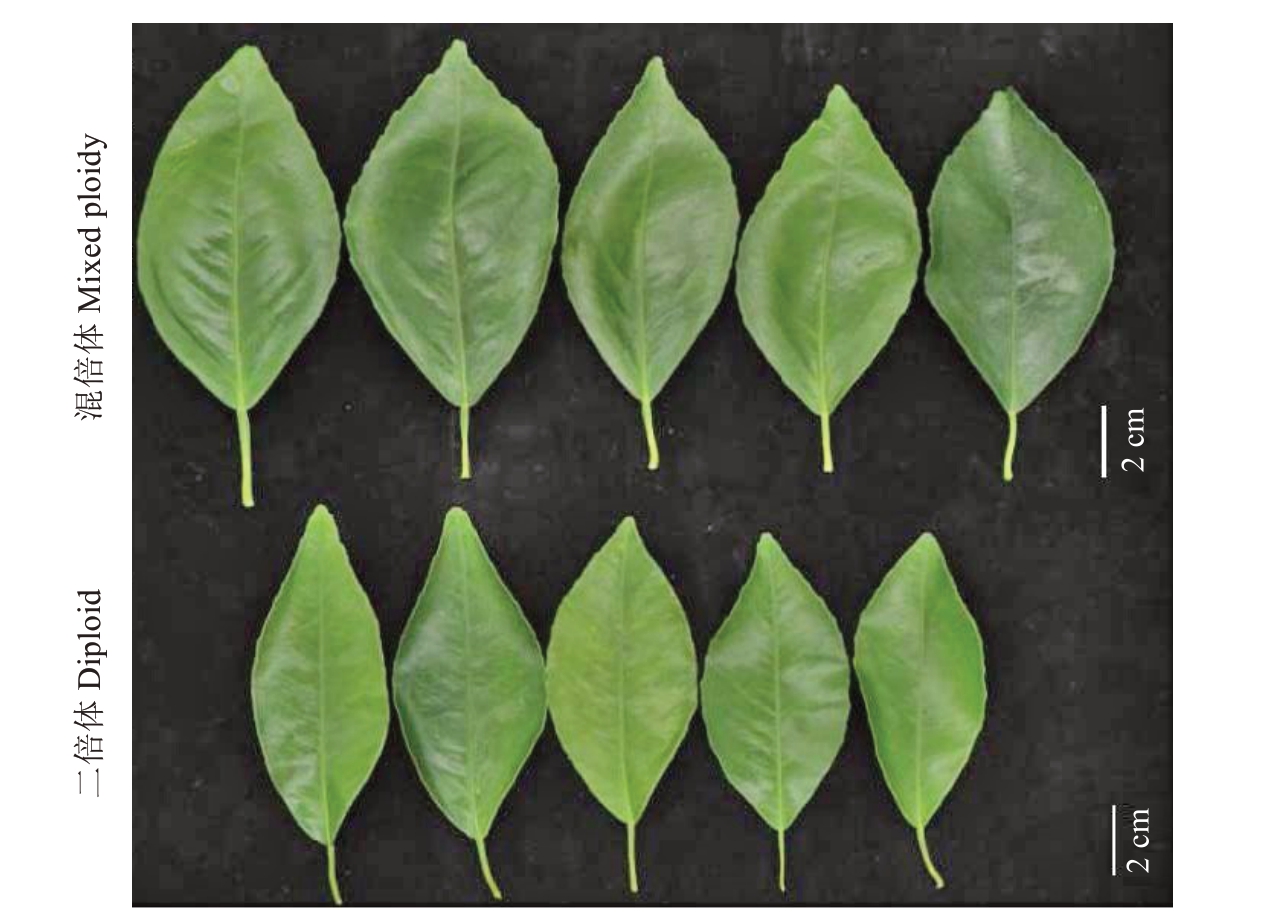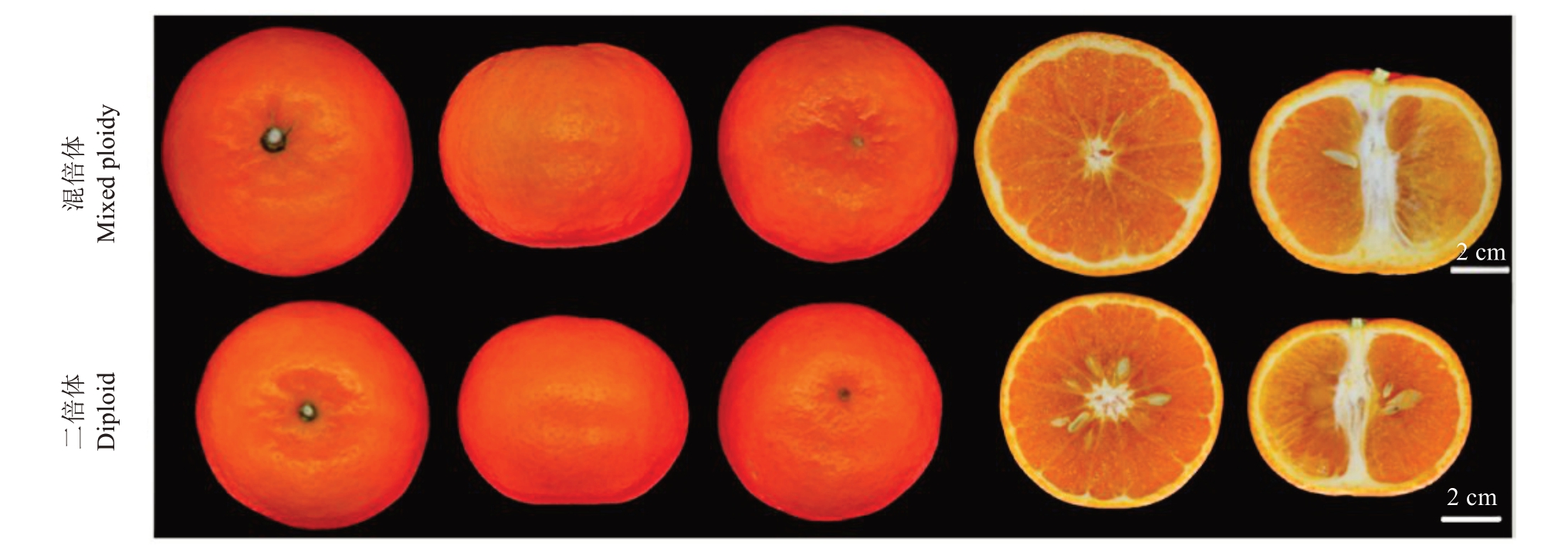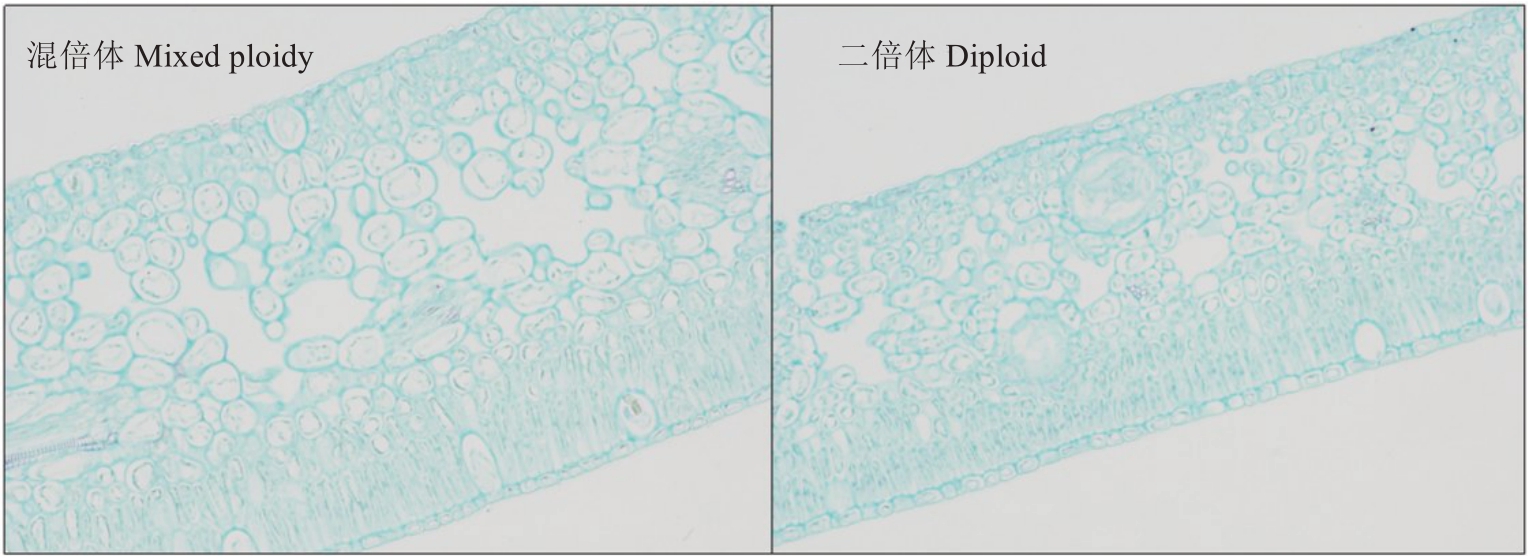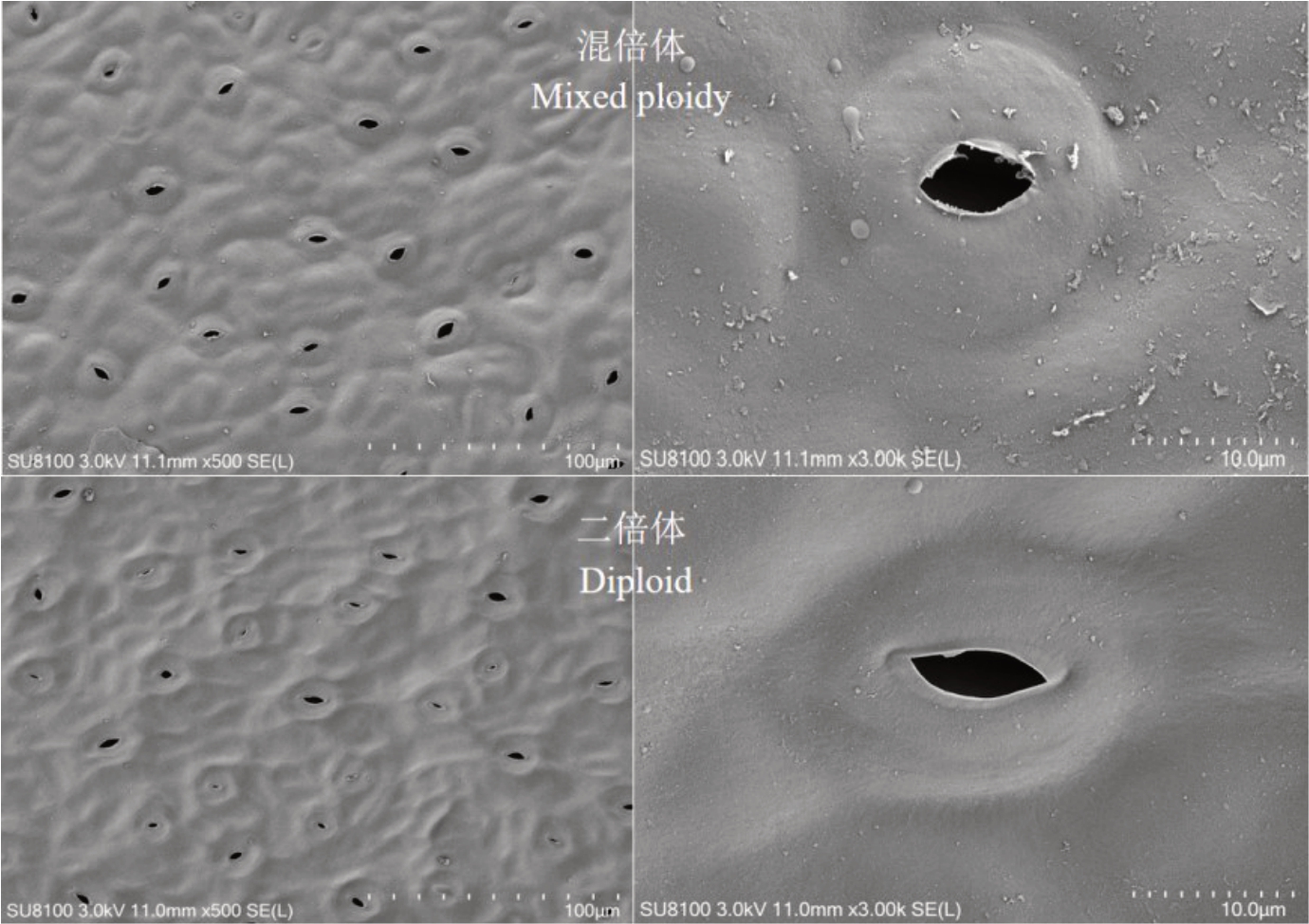沃柑(Citrus reticulata‘Orah’)为单胚性的二倍体品种[1],具有树势强、早结丰产、晚熟、品质优良、外观漂亮等优点。该品种于2012 年首次引种到广西南宁种植,因其优异的表现而成为当前我国发展速度最快、种植面积最广、影响力最大的晚熟柑橘品种,截至2022 年,全国沃柑种植面积已超过20 万hm2。但沃柑在生产上的主要问题是果实种子较多,平均单果种子数约18.9 粒[2],严重影响其食用性和商品性,且沃柑对溃疡病敏感,已成为沃柑种植中最严重的病害[3]。
混倍体(mixed ploidy)是在同一生物组织中有二倍性与非二倍性组织混存的现象[4]。在果树中,混倍体可自然发生,也可以通过嫁接、基因突变、转座子作用、原生质体培养、转基因等获得[5]。混倍体植株由于具有更多的染色体组,相关基因表达量得到提高,其性状也会因此发生变化,往往表现为根、茎、叶、花、果的巨型性,具有果实增大、种子数减少、品质改良、抗逆性增强等优势。刘颖等[6]从冬枣中发现3个二、四混倍体(2x+4x)大果型变异材料,表现出叶片变宽、叶形指数变小,果实变大,果实维生素C含量增加等特性;人工诱导的混倍体桑树鲁诱1号细胞染色体以四倍体为主,混有少量的二倍体,表现出嵌合体效应,既有四倍体叶质优、叶片大、叶肉厚的特点,又有二倍体母本生长旺盛的优点[7];陈立松等[8]首次报道了一个稳定遗传的椪柑突变体桂林良丰,是四倍体与二倍体两种倍性的混倍体,表现出果皮增厚、果实增大、叶片变厚、气孔密度减少等性状[9];二倍体和四倍体的嵌合体品种脆蜜金柑表现出大果、高糖、无核、品质极优等特点[10],已经成为广西金橘的主栽品种。
近年来,柑橘倍性育种及研究取得了较大进展,尤其是大量同源、异源多倍体的筛选和创制,为柑橘新品种选育和基础研究提供了丰富的材料,然而,单胚类型的柑橘多倍体仍然较少[11]。笔者团队前期从沃柑中挖掘到一株沃柑芽变材料,为进一步确定和利用该种质,笔者对其倍性进一步进行鉴定,并系统比较其与沃柑在叶片、花、种子、果等器官的表型、果实品质及叶片显微结构的差异,为未来更好地开发利用该多倍体新种质提供数据基础。
1 材料和方法
1.1 试验材料
2017 年在广西百色市平果县沃柑果园中发现1株沃柑芽变材料,该材料树势强健,叶片卵圆形、大、厚而浓绿,果实大,种子较少。当天剪取芽变接穗进行嫁接扩繁,同时嫁接对照品种沃柑,砧木均为香橙,成活后种植在广西南宁市武鸣区广西农业科学院里建科学研究基地内,2020 年开花结果,于2022年选择该材料及对照品种沃柑开展评价。
1.2 测定方法
1.2.1 倍性鉴定 参照解凯东等[12]的方法进行。
1.2.2 形态特征比较 参照《柑橘种质资源描述规范和数据标准》[13],比较叶片、花、种子、果实主要形态特征,利用万深全功能植物图像分析仪LA-S扫描测量叶片的长度、宽度、周长、面积等指标,计算叶形指数,叶形指数=叶片长度/叶片宽度;用托普云农GY-4硬度计测定果实硬度。叶片、花、种子、果实每10个为1个生物学重复,每个测定指标3次重复。
1.2.3 果实品质测定 果实成熟期,取树冠外围中部生长的大小、均匀一致、有代表性的成熟果实,采用日本ATAGO 公司的PAL-1 便携式数显折光仪测定可溶性固形物含量,采用酸碱滴定法测定果汁可滴定酸含量[14],采用2,6-二氯靛酚法测定果汁维生素C 含量[15],计算可食率、出汁率,每10 个果实为1个生物学重复,每个测定指标3次重复。
1.2.4 叶片解剖结构观测 采用石蜡切片观察叶片解剖结构[16]。摘取待测叶片,将叶片避开叶脉切成0.5 cm2小块状,用FAA 固定液(福尔马林5 mL+乙酸5 mL+70%乙醇90 mL)固定样品1周,脱水,透明后用石蜡包埋,切片,脱蜡,复水。显微镜镜检合格后使用Eclipse Ci-L 拍照显微镜(Nikon,日本)选取组织的目的区域进行200 倍成像。成像完成后使用Image-Pro Plus 6.0 分析软件,以μm 作为标准单位,测量叶片厚度、上表皮厚度、下表皮厚度、栅栏组织厚度、海绵组织厚度。
叶片气孔特征和密度观测[17]:利用扫描电镜进行叶片表皮气孔特征观察。选取同一节位处的叶片,将其切成0.5 cm2小块状,用2.5%戊二醇固定,后经脱水、干燥,再进行导电处理,最后用SU8100扫描电子显微镜(Hitachi,日本)观察叶片下表皮的气孔形态特征,应用Image-Pro Plus 6.0 软件测量计算气孔长度、宽度以及气孔密度(个·mm-2)。
1.3 数据统计分析
采用Excel 2016 处理试验数据,使用DPS 20.0版本以Duncan 新复极差法进行指标间的差异显著性分析。
2 结果与分析
2.1 倍性分析
以二倍体沃柑为对照,在荧光强度100处只有1个二倍体主峰(图1-A),而沃柑少核大果型芽变材料有2 个主峰,峰位置分别在荧光强度100 和200处,且第2 个峰强度为第1 个峰强度的2 倍,为四倍体峰,说明其为二、四混倍体,而且以4x 细胞占优势(图1-B),其中2x 细胞数1199 个,占比39.1%,4x 细胞数量1867个,4x细胞占60.9%。

图1 流式细胞仪检测沃柑及其芽变材料倍性
Fig.1 Flow cytometry detection of ploidy in Orah and its bud mutation material
2.2 形态特征比较
2.2.1 叶片形态特征比较 叶片形状如图2 所示,混倍体沃柑叶片为卵圆形,叶尖短尖,叶片颜色也更加浓绿;二倍体沃柑叶片为阔披针形,叶尖渐尖。混倍体沃柑的叶片长度为101.68 mm、宽度54.29 mm、周长266.02 mm 及叶片面积为3 598.92 mm2,与二倍体沃柑相比分别显著增加14.75%、31.01%、19.38%和46.09%,而叶形指数为1.87,与二倍体沃柑相比显著减少12.61%(表1)。可见随着倍性的增加,叶片变长、变宽,叶形指数变小。
表1 混倍体及二倍体叶片指标比较
Table 1 Comparison of leaf indices between mixed ploidy and diploid

注:不同小写字母表示在p<0.05水平显著差异。下同。
Note:Different small letters indicate significant differences at p<0.05.The same below.
材料Material混倍体Mixed ploidy二倍体Diploid叶片面积Leaf area/mm2 3 598.92±528.33 a 2 463.48±297.51 b叶片长度Leaf length/mm 101.68±8.81 a 88.61±5.66 b叶片宽度Leaf width/mm 54.29±4.22 a 41.44±3.72 b叶形指数Leaf index 1.87±0.15 b 2.14±0.02 a叶片周长Leaf circumference/mm 266.02±19.17 a 222.83±12.73 b

图2 混倍体及二倍体叶片形态
Fig.2 Morphology of mixed ploidy and diploid leaves
2.2.2 花性状分析 混倍体和二倍体沃柑的花均为两性花,二者的花瓣数、花瓣颜色、雄蕊数、花丝离合状态以及花柱状态均相同(图3),混倍体沃柑花瓣长度为14.48 mm,宽度为8.22 mm,与二倍体沃柑相比,分别显著增加34.32%和49.18%(表2),混倍体沃柑表现出花朵较大的特性。
表2 混倍体及二倍体沃柑花指标比较
Table 2 Comparison of flower indices between mixed ploidy and diploid

材料Material混倍体Mixed ploidy二倍体Diploid花性Flower sex两性花Bisexual flowers两性花Bisexual flowers花瓣颜色Petal color白色White白色White花丝离合状态Filament clutch state分离Separation分离Separation花柱状态Style state直立Erect直立Erect花瓣数Petal number 5 5花瓣长度Petal length/mm 14.48±0.18 a花瓣宽度Petal width/mm 8.22±0.08 a雄蕊数Stamen number 18.43±0.98 a 10.78±0.10 b 5.51±0.05 b 18.29±1.11 a

图3 混倍体及二倍体沃柑花形态
Fig.3 Morphology of mixed ploidy and diploid flowers
2.2.3 种子性状 混倍体和二倍体沃柑的种子呈棒形或卵圆形,均为单胚(图4),混倍体的种子单粒质量0.17 g、横径6.39 mm、纵径14.64 mm,均显著大于二倍体,分别比二倍体增加30.77%、8.12% 和26.64%(表3)。
表3 混倍体及二倍体沃柑种子指标
Table 3 Indices of mixed ploidy and diploid seeds

材料Material混倍体Mixed ploidy二倍体Diploid单粒质量Single grain mass/g 0.17±0.03 a 0.13±0.02 b种子横径Seed transverse diameter/mm 6.39±0.75 a 5.91±0.47 b种子纵径Seed longitudinal diameter/mm 14.64±1.85 a 11.56±0.81 b胚类型Embryo type单胚Monoembryony单胚Monoembryony

图4 混倍体及二倍体沃柑种子形态
Fig.4 Morphology of mixed ploidy and diploid seeds
2.2.4 果实形态比较 如图5所示,混体倍沃柑及二倍体沃柑均表现为果皮橙红色,果肉橙黄色,混体倍果实表面光滑度较二倍体稍差,混倍体单果质量206.16 g,果实纵径63.37 mm,横径77.90 mm,果形指数0.81,果皮厚度4.26 mm,果实硬度6.47 kg·cm-2,单果种子数8.2 粒。混倍体的单果质量、果实纵径、果实横径、果形指数、果皮厚度、果实硬度指标均显著大于二倍体,分别增加29.67%、13.38%、8.57%、3.85%、38.31%和16.37%,而单果种子数显著减少61.68%(表4),可以看出混倍体果实较二倍体显著增大,形状变圆,果皮变厚,果实变硬,种子数变少。
表4 混倍体及二倍体沃柑果实指标
Table 4 Indices of mixed ploidy and diploid fruits

材料Material混倍体Mixed ploidy二倍体Diploid单果质量Single fruit mass/g 206.16±11.00 a果实纵径Fruit longitudinal diameter/mm 63.37±2.10 a果实横径Fruit transverse diameter/mm 77.90±1.96 a果形指数Fruit shape index 0.81±0.02 a果皮厚度Pericarp thickness/mm 4.26±0.79 a果实硬度Fruit peel hardness/(kg·cm-2)6.47±1.08 a单果种子数Seed number per fruit 8.2±2.7 b 158.99±9.01 b 55.89±1.47 b 71.75±1.41 b 0.78±0.01 b 3.08±0.35 b 5.56±0.53 b 21.4±4.2 a

图5 混倍体及二倍体沃柑果实形态
Fig.5 Morphology of mixed ploidy and diploid fruits
2.3 果实品质分析
由表5 可知,混倍体沃柑可溶性固形物含量(w,后同)为15.10%,可滴定酸含量为0.58%,与二倍体沃柑相比无显著差异,可食率为69.84%,与二倍体相比显著降低,减少6.15 个百分点,这可能与有较厚的果皮有关;混倍体沃柑出汁率高,表现出水分更足,但与二倍体沃柑差异不显著;维生素C含量(ρ)为23.12 mg·100 mL-1,显著高于二倍体沃柑的16.55 mg·100 mL-1,增加率高达39.70%,部分营养更加丰富。
表5 混倍体及二倍体沃柑果实营养品质指标
Table 5 Nutritional quality indices of mixed ploidy and diploid fruits

材料Material混倍体Mixed ploidy二倍体Diploid w(可溶性固形物)Soluble solid content/%15.10±0.01 a 15.27±0.06 a w(可滴定酸)Titratable acid content/%0.58±0.01 a 0.57±0.02 a可食率Flesh recovery/%69.84±0.97 b 75.99±0.71 a出汁率Fruit juice rate/%63.71±1.74 a 61.06±2.97 a ρ(维生素C)Vitamin C content/(mg·100 mL-1)23.12±0.68 a 16.55±1.89 b
2.4 叶片显微解剖结构观测
如图6 所示,混倍体与二倍体沃柑叶片横切面组织结构的细胞排列顺序基本相同,上、下表皮组织由1层圆形或近圆形的细胞组成,排列整齐,栅栏组织和海绵组织分化明显,栅栏组织靠近上表皮,由2~3 层紧密排布的长条形细胞组成,海绵组织靠近下表皮,形状短圆形,排列不整齐且较为松散。由表6 可知,混倍体的叶片厚度310.96 μm、下表皮厚度12.26 μm、栅栏组织厚度72.89 μm 和海绵组织厚度227.94 μm,均显著高于二倍体,分别增加19.75%、10.10%、9.38%和43.92%,上表皮厚度也增厚,但未达到显著差异。
表6 混倍体及二倍体沃柑叶片横切面组织结构指标
Table 6 Indices of histological structure of cross-sections of mixed ploidy and diploid leaves

材料Material混倍体Mixed ploidy二倍体Diploid叶片厚度Leaf thickness/μm 310.96±13.66 a 259.68±8.95 b上表皮厚度Thickness of upper epidermis/μm 13.41±1.06 a 12.88±0.57 a下表皮厚度Thickness of lower epidermis/μm 12.26±1.14 a 11.13±1.16 b栅栏组织厚度Thickness of palisade tissue/μm 72.89±3.27 a 66.64±3.68 b海绵组织厚度Thickness of sponge tissue/μm 227.94±16.15 a 158.38±5.85 b

图6 混倍体及二倍体沃柑叶片横切面组织结构
Fig.6 Histological structure of cross-section of mixed ploidy and diploid leaves
扫描电镜观察气孔特征显示(图7,表7),混倍体的叶片气孔长度为7.35 μm,宽度为3.33 μm,气孔密度为520.40 个·mm-2,与二倍体相比,气孔长度和气孔密度分别减少7.36%和15.76%,差异显著,而气孔宽度较二倍体显著增加5.09%。
表7 混倍体及二倍体沃柑叶片气孔指标
Table 7 Indices of stomata in mixed ploidy and diploid leaves

材料Material混倍体Mixed ploidy二倍体Diploid气孔长度Stomatal length/μm 7.35±0.02 b气孔宽度Stomatal width/μm 3.33±0.04 a气孔密度Stomatal density/(No.·mm-2)520.40±36.26 b 7.94±0.01 a 3.16±0.03 b 617.76±39.41 a

图7 混倍体及二倍体沃柑叶片气孔特征比较
Fig.7 Comparison of stomatal characteristics between mixed ploidy and diploid leaves
3 讨 论
倍性鉴定是果树倍性育种的重要环节,目前,倍性鉴定的方法有很多,一般可以通过形态特征、细胞学、染色体计数法、分子标记法、流式细胞仪法等其中一种或多种方法进行鉴定[18]。Galbraith等[19]首次报道了利用流式细胞仪快速、准确地测定植物倍性水平,经过多年的不断发展,现如今已被广泛应用并已逐步替代了传统的染色体计数法[20]。研究人员利用该方法对苹果、柑橘[21]、枣、柿、葡萄、猕猴桃、梨[22]等果树资源鉴定出不同的倍性材料。对于混倍体植株,流式细胞仪可以快速检测出不同倍体细胞类型和各种细胞类型所占的比例。在本研究中,笔者从二倍体沃柑中发现叶片增大、果实变大、种子数减少等性状的变异材料,初步认为具有多倍性性状,再通过流式细胞仪对其倍性进行确认,结果变异材料为二、四混体倍,且二倍体与四倍体细胞比例约为4∶6,与亲本沃柑的倍性存在差异。因此,通过形态学鉴定方法初选出多倍体变异植株后,再进一步利用流式细胞仪进行倍性检测是一种快速且有效的方法。
混倍体植物常表现出异于正常倍性植株的特性,出现一些器官“巨大化”,主要表现在叶片、花朵、果实、种子以及气孔等特征上。吴改娥[23]分析了二倍体与四倍体枣树叶片形态,发现四倍体枣树的叶片比二倍体枣树的叶片更大更宽。汪卫星等[24]研究发现三倍体枇杷的树体干周、枝条、叶片和花器官性状均显著大于二倍体。四倍体杂交鹅掌楸与二倍体相比形态上发生明显变化,包括叶片变大变厚、叶色加深、气孔变大等[25]。在本研究中,随着沃柑倍性增加,出现植株叶片显著变大增厚、叶形指数减小、叶色加深、花朵增大、果实增大、种子减少等变化特点,与上述研究有类似结果,可作为前期倍性鉴定的重要筛选依据,在大规模倍性鉴定中能较大程度减少育种人员的工作量。
多倍体植物的表型变异在一定程度上反映了植物对环境的生理适应性,通过改变组织结构来提高植株的抗病抗逆性,其中,植物叶片组织结构是种质资源评价的重要依据之一[26]。多倍体显微结构发生改变,巨大化特征表现突出[27],二、四混倍体芽变品种金冠酥的叶片、茎细胞比二倍体母本酥梨大[28]。溃疡病作为沃柑最主要的病害,气孔作为病原菌侵入的重要途径,其密度、面积与柑橘对溃疡病的抗性呈显著负相关,叶片厚度及叶片栅栏组织、海绵组织、上下表皮厚度等在内的多项形态学指标均与柑橘抗溃疡病能力呈极显著正相关[29]。本研究结果表明,沃柑混倍体的叶片厚度、叶片上下表皮、栅栏组织和海绵组织的厚度均大于二倍体,气孔密度显著减小,意味着有较强的抗逆性,且在实际生产中,笔者也观察到田间混倍体植株对溃疡病的抗性明显强于二倍体,这可能与混倍体叶片结构的改变有关,混倍体的抗病性将作为下一步的研究目标。
植株果实营养品质的优劣是衡量其价值的重要指标,植物多倍体不仅改变了植株的形态,而且改变了果实的营养品质。黄金艳等[30]对不同倍性甜瓜果实品质进行比较研究,发现四倍体维生素C 含量高于三倍体和二倍体,可溶性蛋白和可溶性糖含量具有相同的趋势,依次为三倍体>四倍体>二倍体。亦有研究学者发现四倍体茄子的果实维生素C、蛋白质、脂肪含量较二倍体品种分别增加了74.38%、34.22%和31.30%[31];维生素C 是一种具有多功能的代谢物质,人体不能自身合成,必须从食物中获取,因此维生素C含量已成为衡量果实品质和影响人们选购果品的重要指标。人类日常膳食摄入的维生素C 也主要来源柑橘类水果[32],在本研究中,混倍体沃柑的维生素C 含量达到23.12 mg·100 mL-1,显著高于二倍体沃柑的16.55 mg·100 mL-1,增加率高达39.70%,表现出营养物质更加丰富的特征。
4 结 论
混倍体与二倍体沃柑在叶、花、种子、果实形态、果实品质以及叶片显微结构等方面存在较大差异,具体表现在混倍体沃柑叶片变大变厚,花瓣长度和宽度增大,种子单粒质量、横径和纵径增加而单果种子数减少,叶片、上表皮、下表皮、栅栏组织、海绵组织厚度增厚,气孔长度和密度减小,气孔宽度增加,单果质量、果实横纵径、维生素C含量增加。该混倍体既可作为单胚型少核大果沃柑的新类型加以利用,也可作为新的种质资源进一步用于育种工作。
[1] 袁东亚.以12 个柑橘四倍体为父本倍性杂交培育三倍体[D].武汉:华中农业大学,2018.YUAN Dongya.Production of citrus triploid plants by interploid crossing with twelve tetraploids as pollen parents[D].Wuhan:Huazhong Agricultural University,2018.
[2] 黄其椿,刘吉敏,何新华,黄克,冉志林,吴荣伦,罗捷,李初英.晚熟杂柑‘沃柑’在广西武鸣的栽培表现初报[J].中国南方果树,2014,43(3):86-88.HUANG Qichun,LIU Jimin,HE Xinhua,HUANG Ke,RAN Zhilin,WU Ronglun,LUO Jie,LIChuying.Preliminary study of performance of late maturing hybrid citrus‘Orah’during the cultivation in Wuming of Guangxi[J].South China Fruits,2014,43(3):86-88.
[3] 赵洪涛,陈东奎,陈香玲,欧智涛,黄其椿,张兰,李果果,刘要鑫,叶云峰,付岗.沃柑溃疡病病原菌分离鉴定及防治药剂筛选[J].南方农业学报,2019,50(12):2703-2712.ZHAO Hongtao,CHEN Dongkui,CHEN Xiangling,OU Zhitao,HUANG Qichun,ZHANG Lan,LIGuoguo,LIU Yaoxin,YE Yunfeng,FU Gang.Pathogen identification and bactericide screening of Orah citrus canker[J].Journal of Southern Agriculture,2019,50(12):2703-2712.
[4] 黎月娟.桑树种质资源倍性测定及诱导研究[D].南宁:广西大学,2019.LIYuejuan.Ploidy determination and induction study of mullberry germplasm resources[D].Nanning:Guangxi University,2019.
[5] 朱雪云,陈利萍.植物嵌合体的研究与应用[J].核农学报,2010,24(6):1185-1191.ZHU Xueyun,CHEN Liping.Studies and applications of plant chimeras[J].Journal of Nuclear Agricultural Sciences,2010,24(6):1185-1191.
[6] 刘颖,冯春芳,于洪长,王玖瑞,刘孟军.‘冬枣’天然二、四混倍体的发现与评价[J].园艺学报,2016,43(5):966-974.LIU Ying,FENG Chunfang,YU Hongchang,WANG Jiurui,LIU Mengjun.Discovery and evaluation of natural mixoploid(2x + 4x) variants in Ziziphus jujuba Mill.‘Dongzao’[J].Acta Horticulturae Sinica,2016,43(5):966-974.
[7] 梁明芝.桑树人工诱导混倍体品种‘鲁诱1 号’选育[D].北京:中国农业大学,2005.LIANG Mingzhi.Breeding of artificial-induced mixoploid mulberry variety‘Luyou 1’[D].Beijing:China Agricultural University,2005.
[8] 陈立松,万蜀渊.1 个新的椪柑突变体:‘桂林良丰’无核椪柑的细胞学鉴定[J].武汉植物学研究,1996,14(1):1-5.CHEN Lisong,WAN Shuyuan.Cytological identifications on‘Guilin Liangfeng’seedless ponkan (Citrus reticulata Blanco):A new type mutant of Ponkan[J].Journal of Wuhan Botanical Research,1996,14(1):1-5.
[9] 陈立松,万蜀渊.椪柑混倍体的形态学和细胞学特性研究[J].武汉植物学研究,1998,16(1):89-92.CHEN Lisong,WAN Shuyuan.Studies on the morphological and cytological characteristics of Ponkan(Citrus reticulata Blanco) mixoploid[J].Journal of Wuhan Botanical Research,1998,16(1):89-92.
[10] 唐志鹏,高兴,秦荣耀,孙宁静,蓝惠国,韦日机,邓光宙,刘冰浩.金柑新品种‘脆蜜金柑’的选育[J].果树学报,2018,35(1):131-134.TANG Zhipeng,GAO Xing,QIN Rongyao,SUN Ningjing,LAN Huiguo,WEIRiji,DENG Guangzhou,LIU Binghao.A new Fortunella crassifiolia cultivar‘Cuimi Kumquat’[J].Journal of Fruit Science,2018,35(1):131-134.
[11] 崔璐璐,党江波,韩国辉,郭启高,向素琼,梁国鲁.梨橙有性多倍体发掘及遗传鉴定[J].植物遗传资源学报,2021,22(4):1000-1008.CUILulu,DANG Jiangbo,HAN Guohui,GUO Qigao,XIANG Suqiong,LIANG Guolu.Exploitation and genetic characterization of sexual polyploids from Licheng[J].Journal of Plant Genetic Resources,2021,22(4):1000-1008.
[12] 解凯东,王惠芹,王晓培,梁武军,谢宗周,伊华林,邓秀新,GROSSER J W,郭文武.单胚性二倍体为母本与异源四倍体杂交大规模创制柑橘三倍体[J].中国农业科学,2013,46(21):4550-4557.XIE Kaidong,WANG Huiqin,WANG Xiaopei,LIANG Wujun,XIE Zongzhou,YIHualin,DENG Xiuxin,GROSSER J W,GUO Wenwu.Extensive citrus triploid breeding by crossing monoembryonic diploid females with allotetraploid male parents[J].Scientia Agricultura Sinica,2013,46(21):4550-4557.
[13] 江东.柑橘种质资源描述规范和数据标准[M].北京:中国农业出版社,2006.JIANG Dong.Descriptors and data standard for citrus (Citrus spp.)[M].Beijing:China Agriculture Press,2006.
[14] 国家技术监督局.水果、蔬菜制品可滴定酸度的测定:GB/T 12293—1990[S].北京:中国标准出版社,1990.State Bureau of Quality and Technical Supervision of the People’s Republic of China.Fruit and vegetable products-Determination of titratable acidity:GB/T 12293—1990[S].Beijing:Standards Press of China,1990.
[15] 中华人民共和国国家卫生和计划生育委员会.食品安全国家标准食品中抗坏血酸的测定:GB 5009.86—2016[S].北京:中国标准出版社,2017.National Health and Family Planning Commission of the People’s Republic of China.National Food Safety Standard-Determination of ascorbic acid in food:GB 5009.86—2016[S].Beijing:Standards Press of China,2017.
[16] 韦婉羚,黄珍玲,陈会鲜,杨海霞,兰秀,梁振华,李恒锐.木薯二倍体及其同源四倍体叶片形态、生理及抗螨特征比较[J].核农学报,2022,36(11):2115-2123.WEIWanling,HUANG Zhenling,CHEN Huixian,YANG Haixia,LAN Xiu,LIANG Zhenhua,LIHengrui.Comparison of morphological,physiological and mite resistance characteritics of cassava diploid and its autotetraploid leaves[J].Journal of Nuclear Agricultural Sciences,2022,36(11):2115-2123.
[17] 李润唐,张映南,田大伦.柑橘类植物叶片的气孔研究[J].果树学报,2004,21(5):419-424.LIRuntang,ZHANG Yingnan,TIAN Dalun.Studies on the stomata of citrus plant leaves[J].Journal of Fruit Science,2004,21(5):419-424.
[18] 陈敏敏,张永春,蔡友铭,杨柳燕,聂功平.利用流式细胞术快速鉴定61 份百合品种倍性[J].上海农业学报,2020,36(6):13-17.CHEN Minmin,ZHANG Yongchun,CAIYouming,YANG Liuyan,NIE Gongping.Ploidy identification of 61 lily cultivars by flow cytometry[J].Acta Agriculturae Shanghai,2020,36(6):13-17.
[19] GALBRAITH D W,HARKINS K R,MADDOX J M,AYRES N M,SHARMA D P,FIROOZABADY E.Rapid flow cytometric analysis of the cell cycle in intact plant tissues[J].Science,1983,220(4601):1049-1051.
[20] 逄洪波,高秋,李玥莹,马纯艳,刘宏鑫,杨成瑶,吕瑞雪.利用流式细胞仪测定鬼针草基因组大小[J].基因组学与应用生物学,2016,35(7):1800-1804.PANG Hongbo,GAO Qiu,LIYueying,MA Chunyan,LIU Hongxin,YANG Chengyao,LÜ Ruixue.Genome size estimation of Bidens bipinnata L.by using flow cytometry[J].Genomics and Applied Biology,2016,35(7):1800-1804.
[21] 周锐,解凯东,王伟,彭珺,谢善鹏,胡益波,伍小萌,郭文武.依据多倍体形态特征快速高效发掘柑橘四倍体[J].园艺学报,2020,47(12):2451-2458.ZHOU Rui,XIE Kaidong,WANG Wei,PENG Jun,XIE Shanpeng,HU Yibo,WU Xiaomeng,GUO Wenwu.Efficient identification of tetraploid plants from seedling populations of apomictic citrus genotypes based on morphological characteristics[J].Acta Horticulturae Sinica,2020,47(12):2451-2458.
[22] 齐丹,田路明,董星光,张莹,霍宏亮,徐家玉,刘超,张小双,詹俊宇,张思梦,曹玉芬.梨多倍体种质资源的鉴定[J].中国果树,2023(6):10-15.QIDan,TIAN Luming,DONG Xingguang,ZHANG Ying,HUO Hongliang,XU Jiayu,LIU Chao,ZHANG Xiaoshuang,ZHAN Junyu,ZHANG Simeng,CAO Yufen.Identification of pear polyploid germplasm resources[J].China Fruits,2023(6):10-15.
[23] 吴改娥.二倍体和四倍体枣的比较研究[D].保定:河北农业大学,2011.WU Gaie.Comparative study on diploid and autotetraploid Chinese jujube[D].Baoding:Agricultural University of Hebei,2011.
[24] 汪卫星,李晔,李晓林,向素琼,郭启高,何桥,梁国鲁.天然三倍体枇杷与其二倍体植株的形态学比较[J].果树学报,2011,28(6):1090-1092.WANG Weixing,LIYe,LIXiaolin,XIANG Suqiong,GUO Qigao,HE Qiao,LIANG Guolu.Morphological comparison between natural triploids and diploids in loquat[J].Journal of Fruit Science,2011,28(6):1090-1092.
[25] CHEN T T,SHENG Y,HAO Z D,LONG X F,FU F F,LIU Y,TANG Z H,ALIA,PENG Y,LIU Y,LU L,HU X Y,SHIJ S,CHEN J H.Transcriptome and proteome analysis suggest enhanced photosynthesis in tetraploid Liriodendron sino-america‐num[J].Tree Physiology,2021,41(10):1953-1971.
[26] 陈雪峰,景晨娟,赵习平,武晓红.植物叶片组织结构在抗逆研究中的应用进展[J].河北农业科学,2018,22(3):50-53.CHEN Xuefeng,JING Chenjuan,ZHAO Xiping,WU Xiaohong.Advances in application of plant leaf tissue structure in the research of stress tolerance[J].Journal of Hebei Agricultural Sciences,2018,22(3):50-53.
[27] 崔华蕾,郭欢欢,杨丽晓,马小欣,李探,陈彩霞,梁海永.二倍体及多倍体白榆叶片形态与光合特性分析[J].黑龙江农业科学,2023(3):68-72.CUIHualei,GUO Huanhuan,YANG Lixiao,MA Xiaoxin,LITan,CHEN Caixia,LIANG Haiyong.Leaf morphology and photosynthetic characteristics analysis of diploid and polyploid Ul‐mus pumila[J].Heilongjiang Agricultural Sciences,2023(3):68-72.
[28] 邓舒,张春芬,肖蓉,李倩,李全,曹秋芬.‘酥梨’多倍体芽变新品种‘金冠酥’细胞显微结构观察[J].分子植物育种,2023,21(21):7171-7177.DENG Shu,ZHANG Chunfen,XIAO Rong,LIQian,LIQuan,CAO Qiufen.Anatomical structure of‘Jinguansu’pear,a new polyploid mutant cultivar of‘Suli’[J].Molecular Plant Breeding,2023,21(21):7171-7177.
[29] 潘贞珍,黄运鹏,黄桂香,杨翠红,何新华.3 个柑橘品种叶片结构和生化物质与柑橘溃疡病抗性的相关性研究[J].中国果树,2020(4):31-36.PAN Zhenzhen,HUANG Yunpeng,HUANG Guixiang,YANG Cuihong,HE Xinhua.Correlation research of leaf structure and biochemical substances of three varieties of citrus with the resistance to citrus canker[J].China Fruits,2020(4):31-36.
[30] 黄金艳,王红梅,覃斯华,李文信,何毅,李天艳,洪日新,樊学军,李凤梅.不同倍性甜瓜果实品质比较研究[J].中国农学通报,2011,27(13):238-241.HUANG Jinyan,WANG Hongmei,QIN Sihua,LIWenxin,HE Yi,LITianyan,HONG Rixin,FAN Xuejun,LIFengmei.Comparison of fruit quality in different ploidy melon[J].Chinese Agricultural Science Bulletin,2011,27(13):238-241.
[31] 李树贤,吴志娟,杨志刚,李明珠.同源四倍体茄子品种新茄一号的选育[J].中国农业科学,2002,35(6):686-689.LIShuxian,WU Zhijuan,YANG Zhigang,LIMingzhu.The breeding of autotetraploid eggplant cultivar Xinqie No.1[J].Scientia Agricultura Sinica,2002,35(6):686-689.
[32] BORGHIS M,PAVANELLIW R.Antioxidant compounds and health benefits of citrus fruits[J].Antioxidants,2023,12(8):1526.